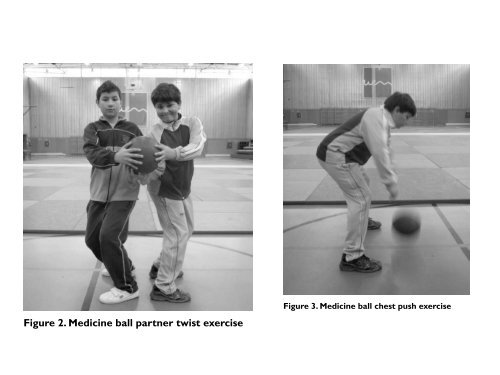You also want an ePaper? Increase the reach of your titles
YUMPU automatically turns print PDFs into web optimized ePapers that Google loves.
t<br />
h<br />
e<br />
r<br />
).<br />
relevance, Foschini et al. (Foschini et al. 2010) reported<br />
similar changes in muscular endurance in obese<br />
adolescents who completed a 14 week aerobic and<br />
resistance training program that followed a linear (i.e.<br />
gradual changes in intensity and volume) or undulating<br />
(i.e., weekly changes in intensity and volume) periodized<br />
training model . However, these researchers also<br />
found that there may be more notable changes in various<br />
metabolic parameters following undulating training<br />
than linear training (Foschini et al. 2010). Although<br />
additional research is needed to examine the effects<br />
of different periodized resistance training programs on<br />
health and fitness outcomes in youth, the importance<br />
of program variation and weekly progression must not<br />
be overlooked if long-term gains in health and performance<br />
are desired.<br />
boredom and promote exercise adherence. Resistance<br />
exercises such as the medicine ball partner can be enjoyable<br />
and effective for school-age youth (Figure 2).<br />
Rest Interval Between Sets and Exercises<br />
In general, the length of the rest interval between<br />
sets and exercises will influence energy recovery and<br />
the training adaptations that take place. Obviously, training<br />
intensity, training goals and fitness level will influence<br />
the rest interval. Although few data examining<br />
the effects of rest interval length on strength performance<br />
in younger populations are available, it appears<br />
that children and adolescents can recover faster than<br />
adults between several repeated sets of resistance<br />
exercise at the same relative intensity (Faigenbaum et<br />
al. 2008). Thus, a shorter rest interval may suffice in<br />
children and adolescents when performing a moderate-intensity<br />
resistance exercise protocol, although the<br />
Figure 2. Medicine ball partner twist exercise<br />
10<br />
Teaching youth about their bodies, promoting safe<br />
Although additional research is needed, it is likely that<br />
the integration of strength and power exercises performed<br />
at different velocities with varying cadences/tempos<br />
within a training program may provide the most<br />
effective training stimulus (McGuigan et al. 2009).<br />
Figure 3. Medicine ball chest push exercise<br />
2011: X (I), 5-14



